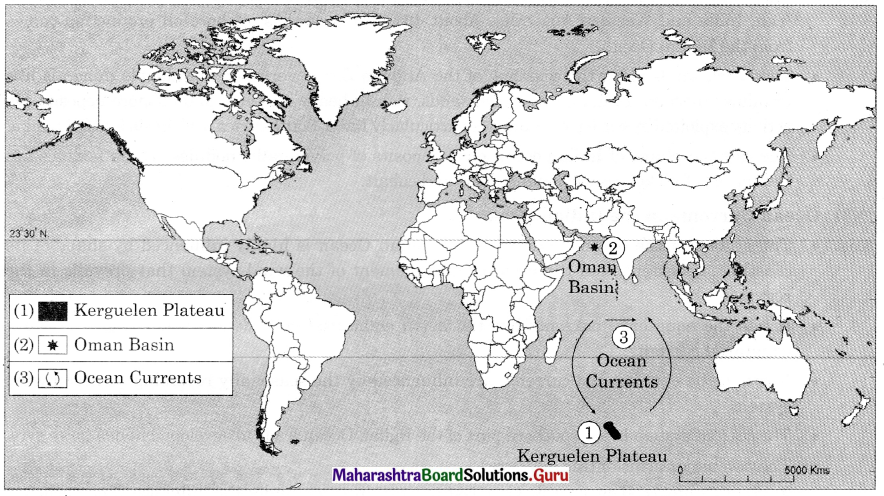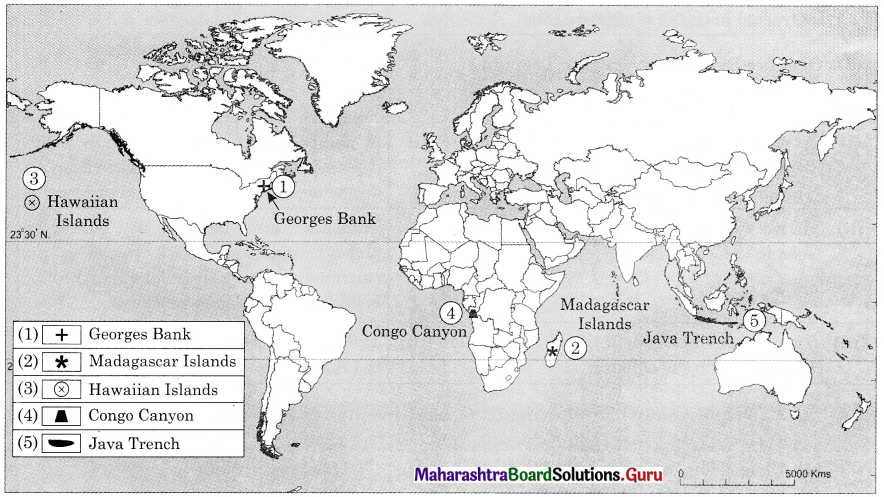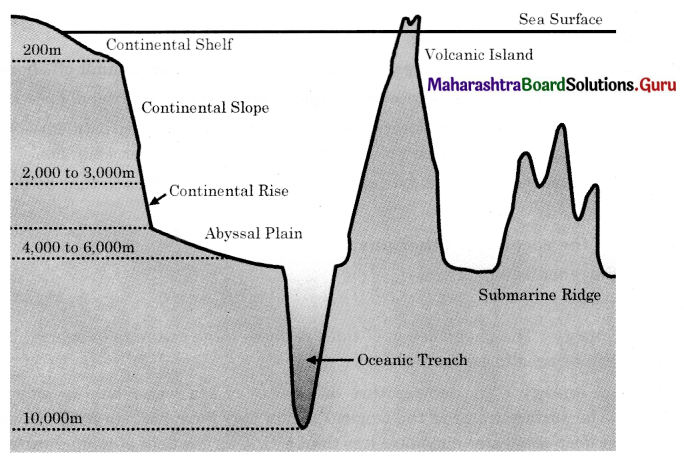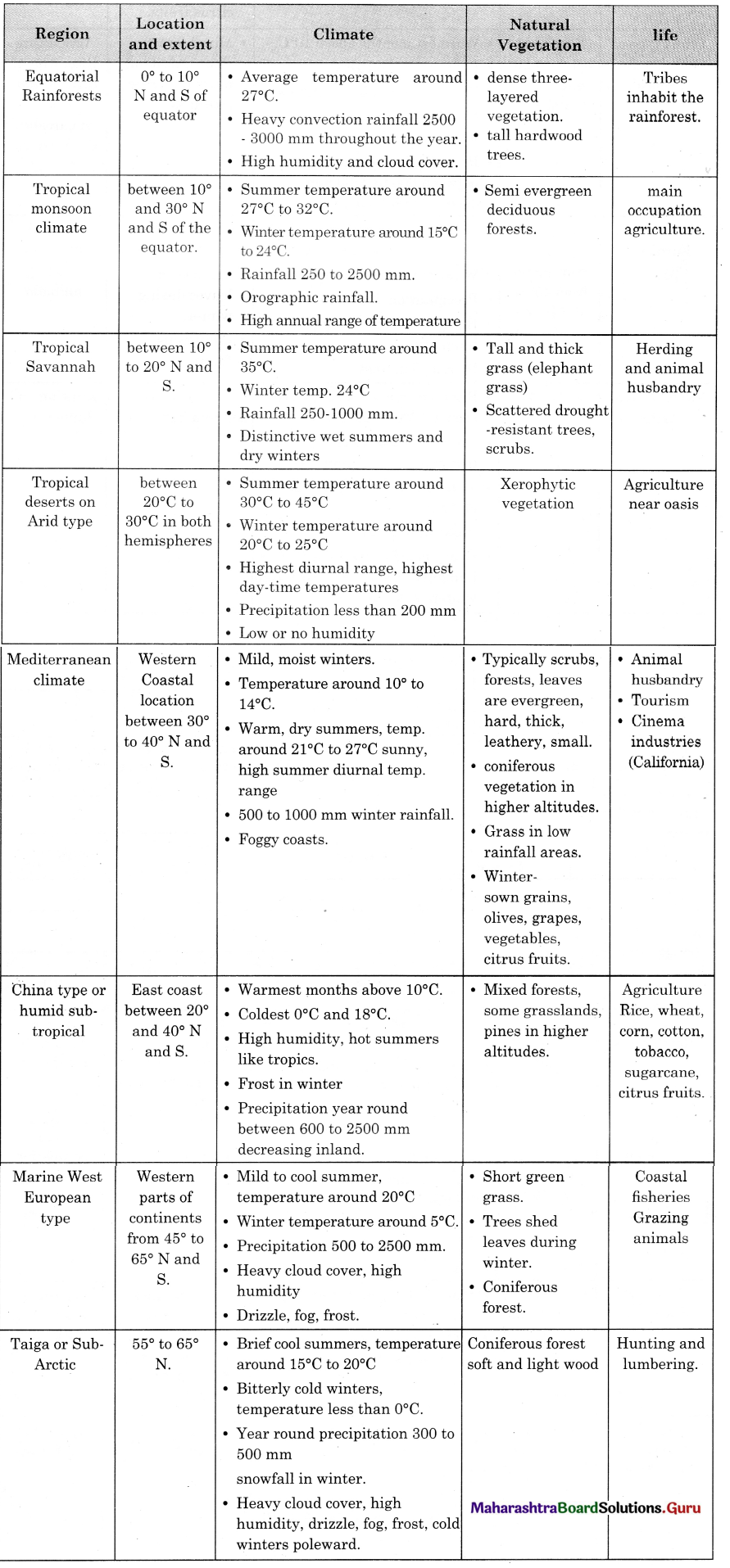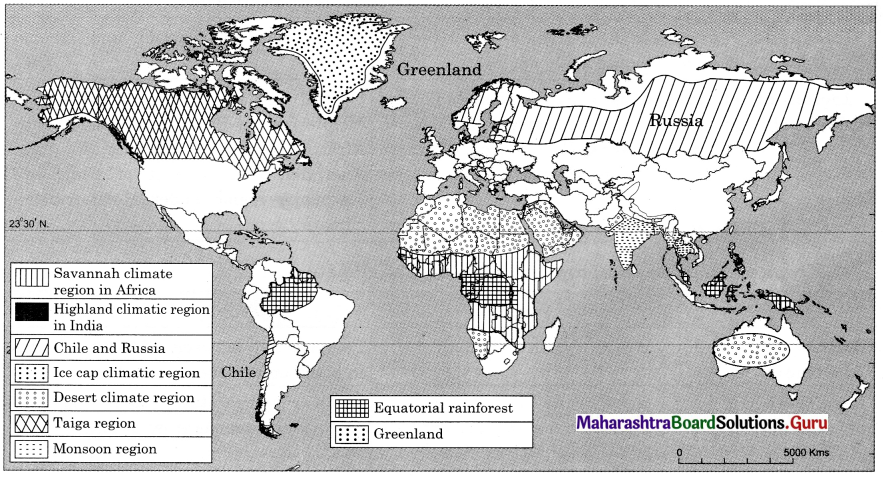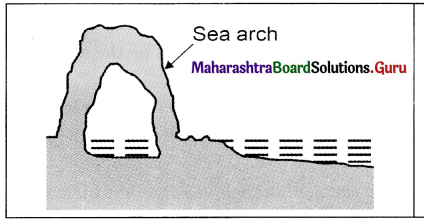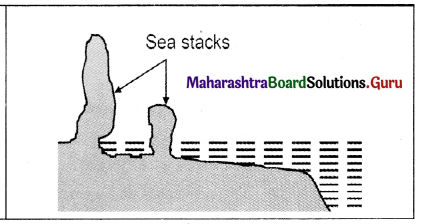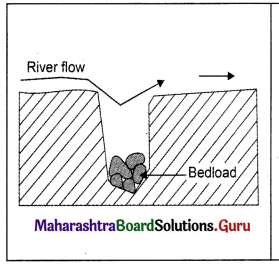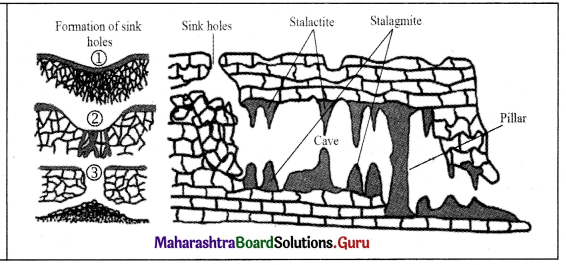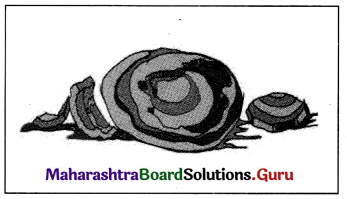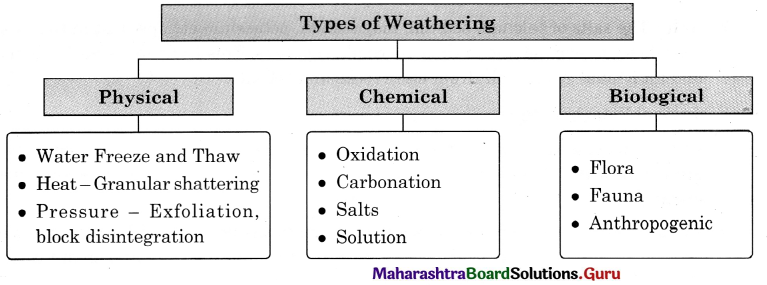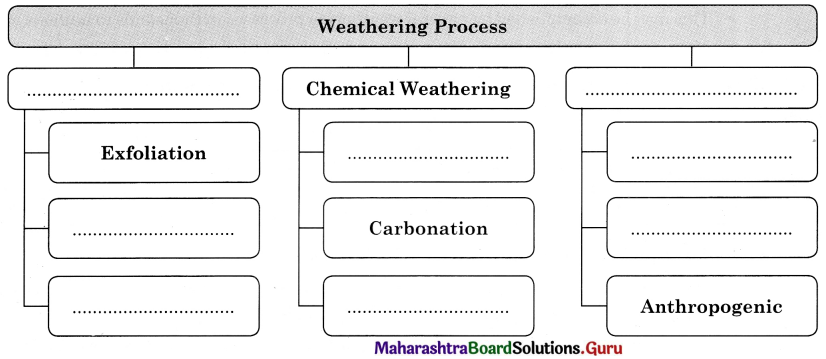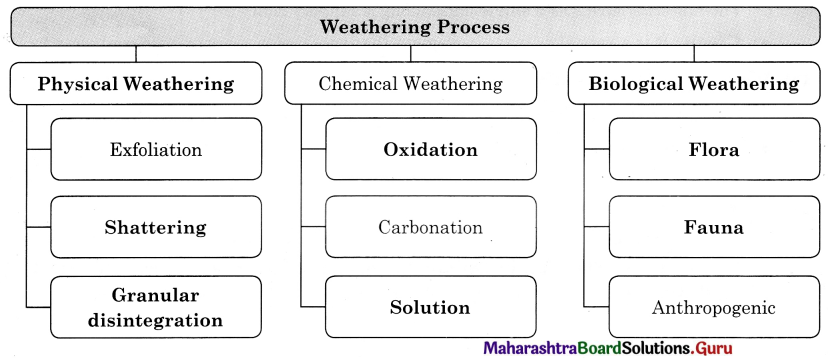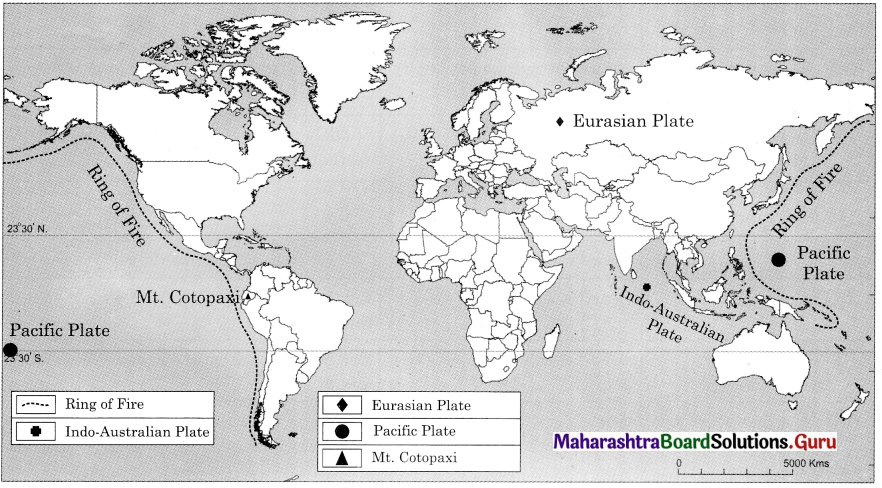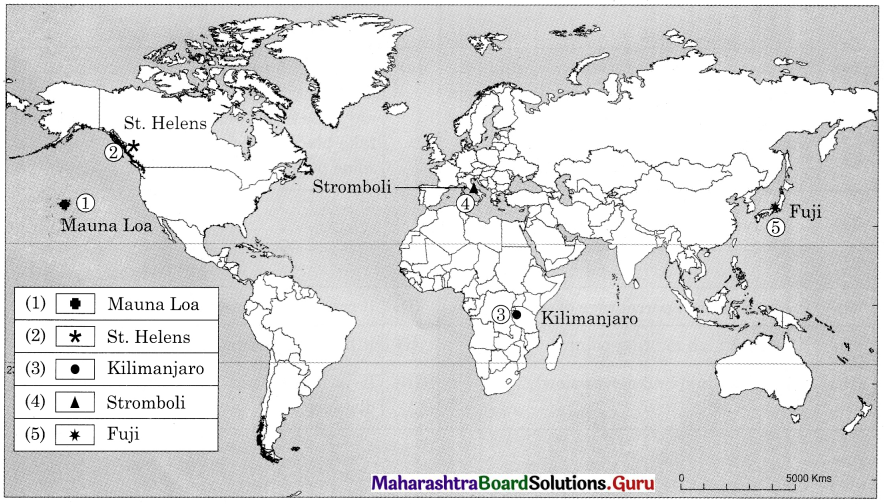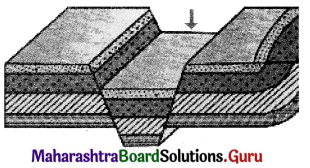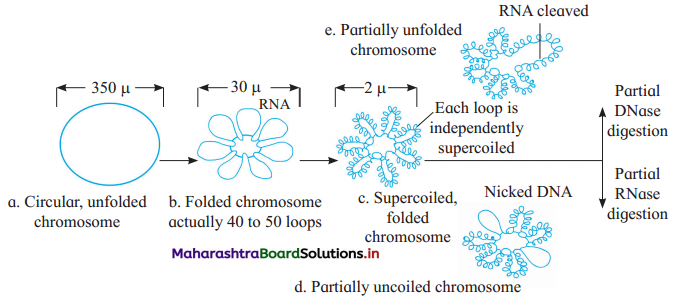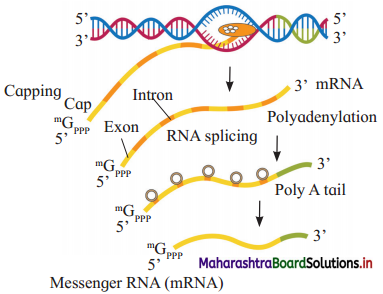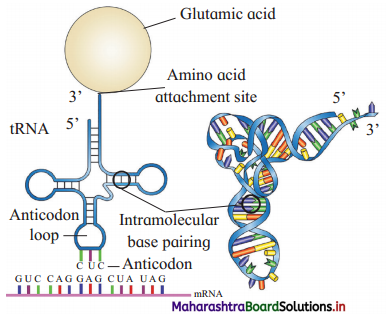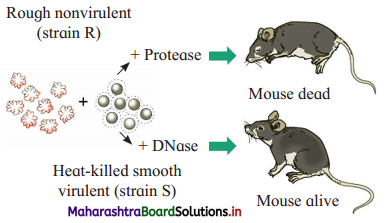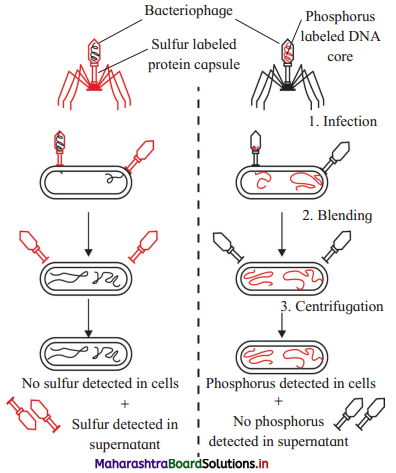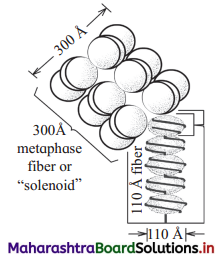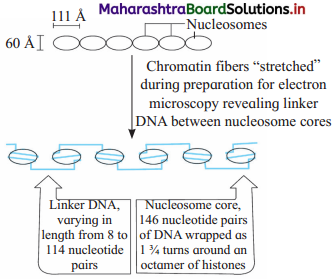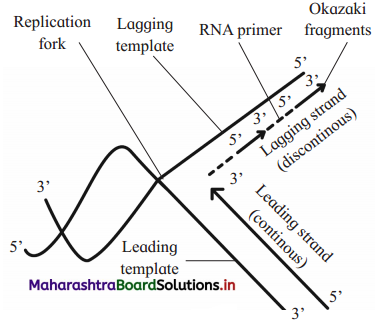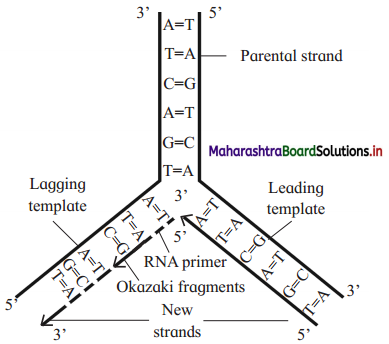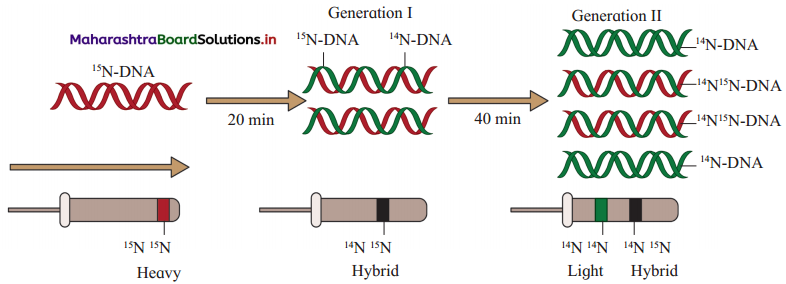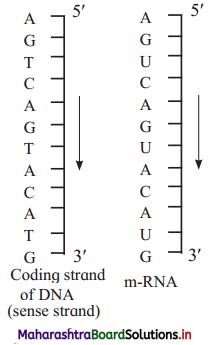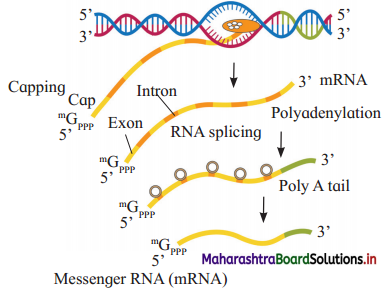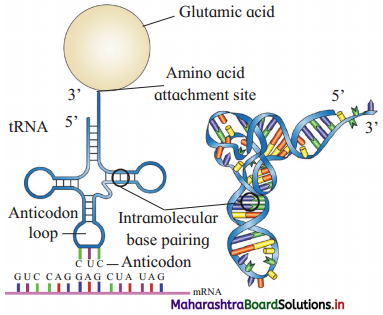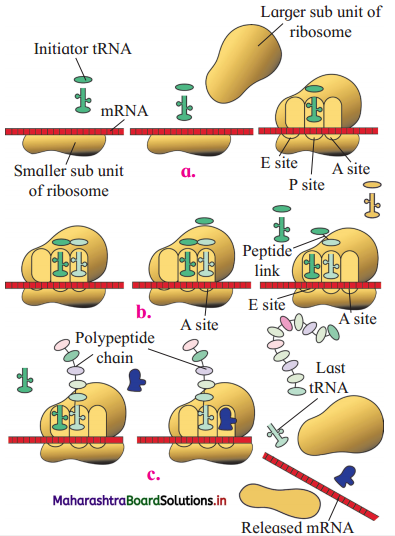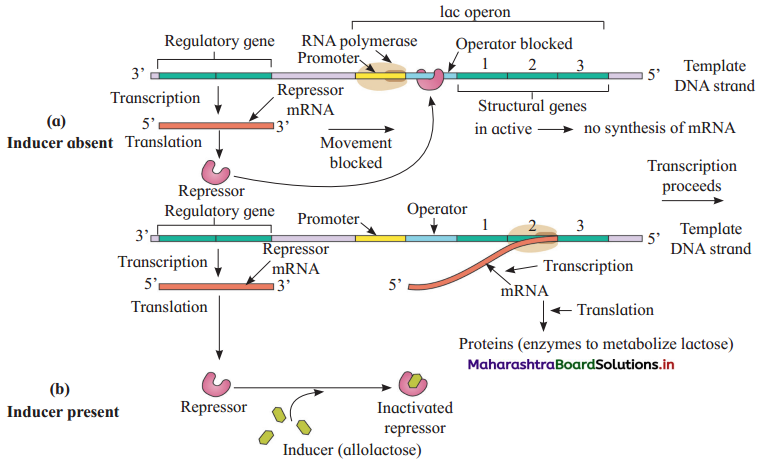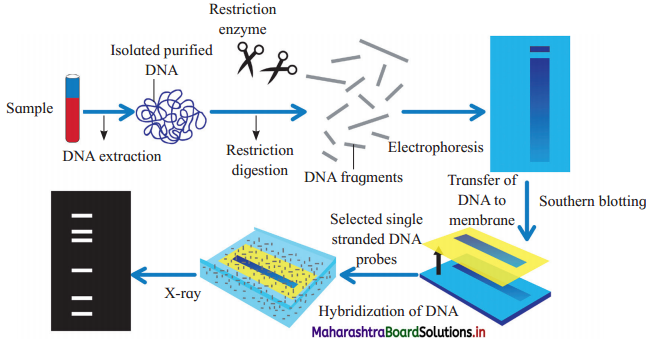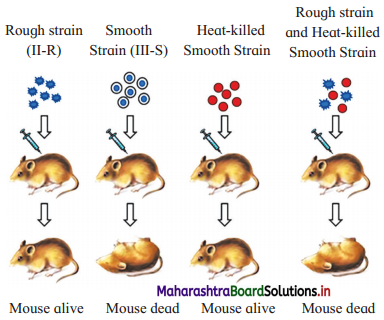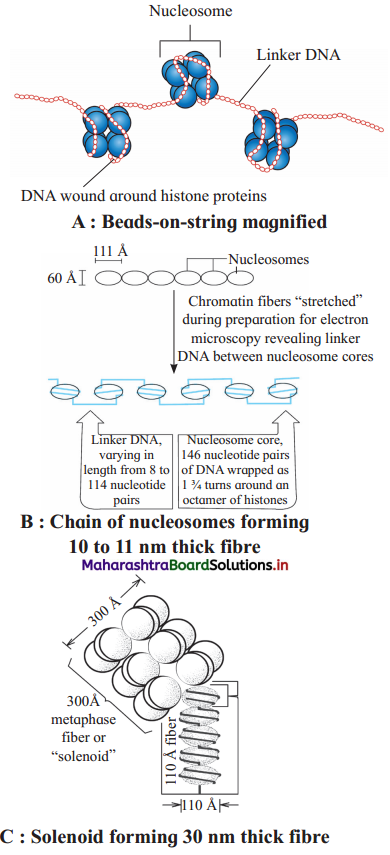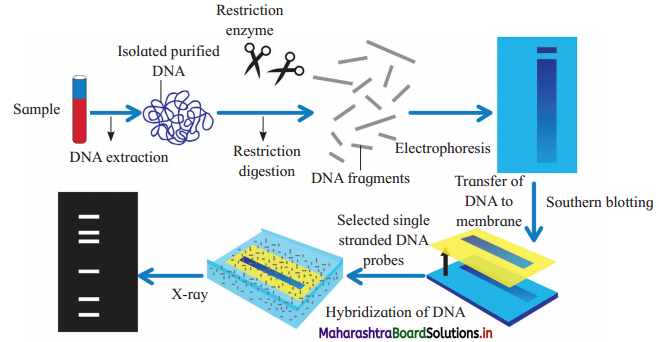Balbharti Maharashtra State Board 12th Biology Important Questions Chapter 5 Origin and Evolution of Life Important Questions and Answers.
Maharashtra State Board 12th Biology Important Questions Chapter 5 Origin and Evolution of Life
Multiple Choice Questions
Question 1.
Which statement is true for the theory of spontaneous generation?
(a) Life came from outer space.
(b) Life can arise from dead matter.
(c) Life can arise from non-living things only
(d) Life arises spontaneously by miracle
Answer:
(c) Life can arise from non-living things only
Question 2.
When man makes the selection during animal husbandry and plant breeding programmes, then it is an example of ……………….
(a) reverse evolution
(b) artificial selection
(c) mutation
(d) natural selection
Answer:
(b) artificial selection

Question 3.
Palaeontological evidences for evolution are ……………….
obtained in the form of
(a) development of embryo
(b) homologous organs
(c) fossils
(d) analogous organs
Answer:
(c) fossils
Question 4.
The homologous organs such as bones of forelimbs of whale, bat, cheetah and man are similar in structure, because ……………….
(a) one organism has given rise to another
(b) they share a common ancestor
(c) they perform the same function
(d) they have biochemical similarities
Answer:
(b) they share a common ancestor
Question 5.
Which type of evolution gives rise to analogous organs?
(a) divergent evolution
(b) parallel evolution
(c) genetic drift
(d) convergent evolution
Answer:
(d) convergent evolution
Question 6.
Hardy Weinberg’s equation of genetic equilibrium i.e. (p + q)² = p² + 2pq + q² = 1 is used in ……………….
(a) population genetics
(b) Mendelian genetics
(c) biometrics
(d) molecular genetics
Answer:
(a) population genetics
Question 7.
Which type of rocks show maximum fossils ?
(a) Sedimentary rocks
(b) Igneous rocks
(c) Metamorphic rocks
(d) Any type of rock
Answer:
(a) Sedimentary rocks
Question 8.
Industrial melanism observed in moth, Biston bitularia shows ………………. type of natural selection.
(a) stabilising
(b) directional
(c) disruptive
(d) artificial
Answer:
(b) directional
Question 9.
Variations during mutations of meiotic recombinations are ……………….
(a) random and directionless
(b) random and directional
(c) small and directional
(d) random, small and directional
Answer:
(a) random and directionless
Question 10.
Theory of special creation is based on ………………. beliefs.
(a) scientific
(b) religious
(c) traditional
(d) mythological
Answer:
(b) religious
Question 11.
Which sentence holds true for theory of biogenesis?
(a) Living organisms arise from non-living things.
(b) Theory of biogenesis can explain origin of life.
(c) Continuity of life can be explained by this theory.
(d) This theory was disproved by Louis Pasteur.
Answer:
(c) Continuity of life can be explained by this theory
Question 12.
Who gave the Big-Bang theory that explained the origin of life ?
(a) Georges Lemaitre
(b) Oparin and Haldane
(c) Charles Darwin
(d) J.B.S. Haldane
Answer:
(a) Georges Lemaitre
Question 13.
Primitive atmosphere of the earth was of type ……………….
la) oxidizing
(b) reducing
(c) aerobic
(d) oxido-reducing
Answer:
(b) reducing
Question 14.
What is the meaning of protobiogenesis?
(a) The origin of life on the earth.
(b) The origin of protozoans on the earth.
(c) The origin of protists on the earth.
(d) The origin of protons of the earth.
Answer:
(a) The origin of life on the earth
Question 15.
What are the first form of life on the earth called ?
(a) Pre-cells or Protobionts
(b) Protoproteins
(c) Coacervates
(d) Chromophores
Answer:
(a) Pre-cells or Protobionts
Question 16.
Which of the following is a landmark in the origin of life ?
(a) Formation of oxygen
(b) Formation of carbohydrates
(c) Formation of proteins
(d) Formation of water
Answer:
(c) Formation of proteins
Question 17.
The first chemicals formed on the earth were ………………. etc.
(a) oxygen, CFC, ozone
(b) DNA. RNA and nucleotides
(c) salt, sugar, proteins
(d) water, ammonia, methane
Answer:
(d) water, ammonia, methane
Question 18.
The unique feature of hot dilute soup is that there was no free ………………. in it.
(a) nitrogen
(b) oxygen
(c) carbon
(d) sulphur
Answer:
(b) oxygen
Question 19.
On which plant did Hugo de Vries work during his experimentations?
(a) Hibiscus rosa sinensis
(b) Oenothera lamarkiana
(c) Mirabilis jalapa
(d) Pisum sativum
Answer:
(b) Oenothera lamarkiana
Question 20.
Which one out of the following is a connecting link between fish and amphibian ?
(a) Archaeopteryx
(b) Seymouria
(c) Ichthyostega
(d) Dinosaurus
Answer:
(c) Ichthyostega
Question 21.
Homologous organs always lead to ………………. evolution.
(a) convergent
(b) divergent
(c) parallel
(d) radiating
Answer:
(b) divergent
Question 22.
Find the odd one out
(a) Caecum
(b) Nictitating membrane
(c) Coccyx
(d) Sacrum
Answer:
(d) Sacrum
Question 23.
The most common types of fossils are ……………….
(a) moulds
(b) casts
(c) actual remains
(d) model
Answer:
(c) actual remains
Question 24.
In geological time scale which period showed dominance of reptiles ?
(a) Triassic
(b) Jurassic
(c) Cretaceous
(d) Eocene
Answer:
(b) Jurassic
Question 25.
Which was the period of beginning of modern birds ?
(a) Triassic
(b) Jurassic
(c) Cretaceous
(d) Eocene
Answer:
(c) Cretaceous
Question 26.
Which epoch showed mammals at height of evolution ?
(a) Eocene
(b) Oligocene
(c) Miocene
(d) Pliocene
Answer:
(c) Mlocene
Question 27.
When did Holocene began ? (mya = million years ago)
(a) 2 mya
(b) 1 mya
(c) 0.5 mya
(d) 0.01 mya
Answer:
(d) 0.01 mya
Question 28.
Cichlid fishes in Lake Victoria are representatives of ………………. type of speciation.
(a) allopatric
(b) sympatric
(c) isolation
(d) random
Answer:
(b) sympatric
Question 29.
Which is the offspring of male horse and female donkey?
(a) Mule
(b) Hinny
(c) Marino
(d) Baroque
Answer:
(b) Hinny
Question 30.
Which one out of the following is a living fossil ?
(a) Coelacanth
(b) Lung fish
(c) Shark
(d) Rays
Answer:
(a) Coelacanth
Question 31.
Giant cephalopods like Nautilus were present in ………………. period.
(a) Silurian
(b) Devonian
(c) Ordovician
(d) Permian
Answer:
(c) Ordovician

Question 32.
First modern birds were formed during ………………. period.
(a) Triassic
(b) Jurassic
(c) Cretaceous
(d) Eocene
Answer:
(c) Cretaceous
Question 33.
When did man emerge during evolutionary time period ?
(a) Eocene
(b) Oligocene
(c) Miocene
(d) Pliocene
Answer:
(d) Pliocene
Question 34.
Find the odd monkey out:
(a) Baboons
(b) Gibbons
(c) Macaques
(d) Langurs
Answer:
(b) Gibbons
Question 35.
Who was man with ape-brain ?
(a) Pithecanthropus
(b) Dryopithecus
(c) Australopithecus
(d) Neanderthal man
Answer:
(c) Australopithecus
Question 36.
Who was the first true man ?
(a) Pithecanthropus
(b) Cro-magnon
(c) Australopithecus
(d) Neanderthal man
Answer:
(a) Pithecanthropus
Question 37.
Which one of the following is not present in human beings ?
(a) S curves in vertebral column
(b) Orthognathus face
(c) Simian gap
(d) Chin
Answer:
(c) Simian gap
Question 38.
Which is the correct sequence of human evolution ?
(a) Australopithecus → Ramapithecus → Homo sapiens → Homo habilis
(b) Homo erectus → Homo habilis → Homo sapiens
(c) Ramapithecus → Homo habilis → Homo erectus → Homo sapiens
(d) Australopithecus → Ramapithecus → Homo erectus → Homo habilis → Homo sapiens.
Answer:
(c) Ramapithecus – Homo hablUs -‘ Homo erectus Homo sapiens
Question 39.
Fossils of Homo erectus were obtained in ………………. and ……………….
(a) Kenya, Shivalik hills
(b) Java, Peking
(c) Africa, Asia
(d) Neanderthal valley, Taung
Answer:
(b) Java, Peking
Question 40.
Dentition more like that of the modern man was seen for the first time in ……………….
(a) Dryopithecus
(b) Ramapithecus
(c) Australopithecus
(d) Homo habilis
Answer:
(d) Homo habilis
Question 41.
Lemur and Tarsier belongs to ……………….
(a) Prosimi
(b) Hyalobatidae
(c) Pongidae
(d) Homonidae
Answer:
(a) Prosimi
Match the columns
Question 1.
| Geological time |
Animal life |
| (1) Cambrian |
(a) Amphibians |
| (2) Ordovician |
(b) First terrestrial animals |
| (3) Silurian |
(c) Jawless fishes |
| (4) Devonian |
(d) Trilobite |
Answer:
| Geological time |
Animal life |
| (1) Cambrian |
(d) Trilobite |
| (2) Ordovician |
(c) Jawless fishes |
| (3) Silurian |
(b) First terrestrial animals |
| (4) Devonian |
(a) Amphibians |
Question 2.
| Human stage |
Cranial capacity in CC |
| (1) Homo sapiens |
(a) 650-800 |
| (2) Homo neanderthalensis |
(b) 900 |
| (3) Homo habilis |
(c) 1400 |
| (4) Homo erectus |
(d) 1450 |
Answer:
| Human stage |
Cranial capacity in CC |
| (1) Homo sapiens |
(d) 1450 |
| (2) Homo neanderthalensis |
(c) 1400 |
| (3) Homo habilis |
(a) 650-800 |
| (4) Homo erectus |
(b) 900 |
Classify the following to form Column B as per the category given in Column A
Question 1.
Nictitating membrane, Seymouria, Lung fish, Flipper of whale and wing of bird, Wing of insect and wing of bird, wisdom
tooth, Eye of octopus, an eye of mammal, vertebrate heart and brain.
| Column I |
Column II |
| (1) Homologous organs |
————- |
| (2) Analogous organs |
————- |
| (3) Vestigial organs |
————- |
| (4) Connecting links |
————- |
Answer:
| Column I |
Column II |
| (1) Homologous organs |
Flipper of whale and wing of bird, Vertebrate heart and brain |
| (2) Analogous organs |
Wing of insect and wing of bird. Eye of octopus, an eye of mammal |
| (3) Vestigial organs |
Nictitating membrane, wisdom tooth |
| (4) Connecting links |
Seymouria, Lung fish |

Question 2.
Origin of conifers, Abundance of trilobites, Diversification of fishes, All types of marine algae, Formation of forests, Rise of dinosaurs, Extinction
| Geological time period |
Major events |
| Cambrian |
————- |
| Devonian |
————- |
| Permian |
————- |
| Triassic |
————- |
Answer:
| Geological time period |
Major events |
| Cambrian |
Abundance of trilobites, All types of marine algae |
| Devonian |
Diversification of fishes, Formation of forests |
| Permian |
Origin of conifers. Rise of modern insects. |
| Triassic |
Rise of dinosaurs, Extinction of seed ferns |
Very short answer questions
Question 1.
What is protobiogenesis?
Answer:
The origin of life on the earth is called protobiogenesis.
Question 2.
What are panspermia?
Answer:
Panspermia or cosmozoa are considered to be spores through which life came on the earth from distant planets.
Question 3.
What are protobionts?
Answer:
Protobionts were first form of life which were formed by nucleic acids along with other inorganic and organic molecules. They have some properties of living form.
Question 4.
What are eobionts?
Answer:
Eobionts or protocells are the first primitive living system which are formed by colloidal aggregations of lipids and proteinoids.
Question 5.
When did universe originate? How?
Answer:
Universe originated about 20 billion years ago by huge titanic explosion called big- bang.
Question 6.
What were the different energy sources during primitive times when earth was cooling?
Answer:
The different available energy sources during primitive times were ultra-violet rays, radiations, lightning and volcanic activities.
Question 7.
How was first cell formed on the primitive earth?
Answer:
In the protocell, when RNA or DNA system developed and they started regulating various metabolic activities, then it was called a first cell.
Question 8.
How was first cell formed on the primitive earth?
Answer:
In the protocell, when RNA or DNA system developed and they started regulating various metabolic activities, then it was called a first cell.
Question 9.
How was first cell on the earth in its metabolism ?
Answer:
First cell was anaerobic, heterotrophic and obtained energy by chemoheterotrophic processes.
Question 10.
What are ribozymes?
Answer:
Ribozymes are catalytic RNA which act as biocatalyst.

Question 11.
Who disproved Lamarck’s theory?
Answer:
August Weismann disproved Lamarck’s theory.
Question 12.
Write theory of germplasm as suggested by Wallace.
Answer:
The theory of germplasm says that variations produced in germ cells or germplasm are inherited to next generations, but the somatic variations present in somatoplasm or somatic cells are not inherited.
Question 13.
Who are the main contributors of modem : synthetic theory of evolution?
Answer:
R. Fischer, J. B. S. Haldane, T. Dobzhansky, Huxley, E. Mayr, Simpson, Stebbins, Fisher, Sewall Wright, Medel, T. H. Morgan, etc. are the main contributors of modern theory of evolution.
Question 14.
What is variation?
Answer:
The variations are the differences that occur in morphology, physiology, nutrition, habit, behavioural patterns, etc.
Question 15.
What is mutation?
Answer:
Sudden, large, inheritable and drastic change occurring in the genetic constitution is called mutation.
Question 16.
What is gene frequency?
Answer:
Gene frequency is the relative frequency of an allele or a gene at a particular locus in a population, as compared to other genes, expressed as a fraction or percentage.
Question 17.
What is the other name for genetic drift?
Answer:
Sewall wright effect is the other name for genetic drift.
Question 18.
Why is genetic drift called founder’s effect?
Answer:
The allelic frequency of new population which undergoes genetic drift becomes different from the original one, thus the original drifted population becomes different and are called ‘founders’. Since founders are formed therefore genetic drift is called founder’s effect.
Question 19.
What are fossils?
Answer:
Fossils are the dead remains of plants and animals from prehistoric times, which are found in different forms such as moulds, casts, actual remains or compression seen in various geological layers.
Question 20.
What is embryology?
Answer:
Embryology is the branch of biology and medicine which deals with study of embryos and their development.
Give definition of the following
Question 1.
Gene flow
Answer:
The transfer of genes between two genetically different populations among themselves is called gene flow.
Question 2.
Genetic drift
Answer:
Any random fluctuation (alteration) in allele frequency, occurring in the natural population by pure chance, is called genetic drift.
Question 3.
Chromosomal aberrations
Answer:
The structural, morphological change in chromosome due to rearrangement, is called chromosomal aberrations.
Question 4.
Mendelian population
Answer:
Small interbreeding group of a population is defined as Mendelian population.
Question 5.
Crossing over
Answer:
Exchange of genetic material between non-sister chromatids of homologous chromosomes in sexually reproducing organisms, during gamete formation is called crossing over.
Question 6.
Saltation
Answer:
Saltation is defined as single step large mutation.
Name the following
Question 1.
The book written by Charles Darwin after returning from voyage.
Answer:
Origin of species by natural selection.
Question 2.
Five main postulates of Darwinism.
Answer:
- Overproduction
- Struggle for existence
- Organic variations
- Natural selection
- Origin of next species.
Question 3.
Five key factors of evolution as suggested by Stebbins.
Answer:
- Gene mutations
- Mutations in the chromosome structure and number
- Genetic recombinations
- Natural selection
- Reproductive isolation.

Question 4.
Name the four types of chromosomal aberrations.
Answer:
- Deletion
- Translocation
- Duplication
- Inversion
Question 5.
Name of the insect that displayed industrial melanism and the name of the scientist who studied them.
Answer:
Kettlewell reported that Biston betularia or peppered moth displayed industrial melanism.
Question 6.
Example of homologous organs in plants.
Answer:
Thorns of Bougainvillea and tendrils of Cucurbita.
Question 7.
Example of analogous organs in plants.
Answer:
Sweet potato and potato.
Question 8.
Pre-mating isolating mechanisms.
Answer:
- Habitat or ecological isolating mechanism
- Seasonal or temporal isolating mechanism
- Ethological isolating mechanism
- Mechanical isolating mechanism
Question 9.
Post-mating isolating mechanisms.
Answer:
- Gamete mortality
- Zygote mortality
- Hybrid sterility
Question 10.
Name of connecting link between reptiles and birds.
Answer:
Archaeopteryx is the connecting link between reptiles and birds.
Question 11.
Name of connecting link between amphibians and reptiles.
Answer:
Seymouria is the connecting link between amphibians and reptiles.
Question 12.
Name of connecting link between fish and amphibians.
Answer:
Ichthyostegia is a missing link between fish and amphibians.
Question 13.
Name the period that was dominant for Amphibia.
Answer:
Carboniferous is dominant period for Amphibia.
Question 14.
Name the epoch when mammals were at the height of evolution.
Answer:
Miocene epoch.
Question 15.
Name the era when birds began to origin.
Answer:
Mesozoic era.
Question 16.
Name the three subclasses of Class Mammalia.
Answer:
- Marsupials
- Monotremes
- Eutheria
Question 17.
Name the three subfamilies of family Hominoidea.
Answer:
- Hyalobatidae
- Pongidae
- Hominidae
Give the significance of the following
Question 1.
Significance of Natural selection
Answer:
- Natural selection is the main driving force behind the evolution.
- Natural selection favours those genetic variations which have better fitness value.
- Such organisms are at selective advantage and they produce more offspring than the rest. Such organisms have greater survival and reproductive capacity.
- In this way natural selection helps in the evolution of new species.
- Natural selection favours differential reproduction of gene and brings about changes in the gene frequency.
- Natural selection brings about evolutionary changes.
- Natural selection also eliminates the genes carrying harmful mutations. This is called mutation balance in which allele frequency of harmful recessives remain constant generation after generation.
Distinguish between the following
Question 1.
Gene flow and Genetic drift.
Answer:
| Gene flow |
Genetic drift |
| 1. Gene flow is the alteration in the gene frequency due to migrations. |
1. Genetic drift is alteration in the gene frequency by pure chance. |
| 2. Gene flow occurs due to exchange of genes in the adjacent populations through interbreeding. |
2. Genetic drift occurs due to accidental and sudden elimination of a particular gene. |
| 3. Larger populations tend to show more migrations and hence more gene flow. |
3. Smaller populations have greater chances of genetic drift. |
| 4. Gene flow occurs due to emigration and immigration. |
4. Genetic drift occurs only within the specified population. |

Question 2.
Directional, Stabilizing and Disruptive selection.
Answer:
| Directional selection |
Stabilizing selection |
Disruptive selection |
| 1. Natural selection operating in a linear direction is called directional selection. |
1. Natural selection operating to balance or stabilize the population is called stabilizing selection. |
1. Natural selection which disrupts the mean characteristics of a population is called disruptive selection. |
| 2. In directional selection, more individuals acquire characters other than the mean character value. |
2. In stabilizing selection, more individuals of a population acquire a mean character value. |
2. In disruptive selection, more number of individuals acquire extreme or peripheral character value. |
| 3. Directional selection eliminates one of the extremes of the phenotypic range and favour the other. |
3. Stabilizing selection tends to favour the intermediate forms and eliminate both the phenotypic extremes. |
3. Disruptive selection favours extreme phenotypes and eliminate intermediate. |
| 4. It streamlines variations. |
4. It reduces variations. |
4. It increases variations. |
| 5. This kind of selection is the most common. |
5. This kind of selection is common. |
5. This kind of selection is rare. |
| 6. Directional selection operates for many generations, it results in an evolutionary trend within a population and shifting a peak in one direction.
E.g. Industrial melanism, DDT resistance in mosquito, etc. |
6. This selection leads to evolutionary change but tend to maintain phenotypic stability within population.
E.g. All the populations which have adapted to their environment. |
6. It ensures the effect on the entire gene pool of a population, considering all mating types or systems.
E.g. African seed cracker finches with different sized beaks |
Question 3.
Homologous organs and Analogous organs.
Answer:
| Homologous organs |
Analogous organs |
| 1. Homologous organs are structurally similar to one another. |
1. Analogous organs are structurally dissimilar to one another. |
| 2. Homologous organs are functionally dissimilar from one another. |
2. Analogous organs are functionally similar to one another. |
| 3. Homologous organs help in tracing the evolutionary relationships. |
3. Analogous organs do not help in tracing the evolutionary relationships. |
| 4. Homologous organs lead to divergent evolution. |
4. Analogous organs lead to convergent evolution. |
| 5. Animals residing in different habitats but having closer evolutionary relationship show homologous organs.
E.g. Forelimbs of frog, lizard, bird, bat, whale, man, etc. |
5. Diverse animals residing in the similar habitat show analogous organs.
E.g. Wing of a bird and wing of an insect. |
Question 4.
Allopatric and Sympatric speciation.
Answer:
| Allopatric speciation |
Sympatric speciation |
| 1. Allopatric speciation is the formation of a new species due to separation of a segment of population from the original population. |
1. Sympatric speciation is the formation of species within single population. |
| 2. There is geographical barrier cutting across the species range during such speciation. |
2. There is no geographical isolation during sympatric speciation. |
| 3. Allopatric speciation does not have physiological barrier. |
3. Sympatric speciation is due to physiological or reproductive isolating barrier. |
| 4. Migration of individual are also helpful in allopatric speciation. E.g. African elephant and Indian elephant. |
4. Mutations are helpful in sympatric speciation. E.g. Cichlid fishes in Lake Victoria. |
Give scientific reasons
Question 1.
Simple organic molecules did not show decomposition in primitive oceans.
Answer:
Simple organic molecules which were formed during chemical evolution, accumulated at the bottom of water bodies. At that time there was no free oxygen and enzymes. Therefore, simple organic molecules did not show decomposition in primitive oceans.
Question 2.
Archaeopteryx is called connecting link between reptiles and birds.
Answer:
(1) Archaeopteryx shows reptilian as well as avian characters.
(2) Reptilian characters are as follows:
- Jaws with homodont (all similar) teeth. Bones are nonpneumatic i.e. solid.
- Ribs have a single head. Sternum without keel.
- Abdominal ribs present which are like the crocodilian ribs.
- Forearms have three digits ending in distinct claws while the hind limb has four digits ending in clawed digits.
(3) Avian characters shown by it are as follows:
- Forearms modified into wings.
- Feathery exoskeleton.
- Skull bones are completely fused.
- Cranium is rounded with large orbits and a single condyle.
- Jaws are modified into beak.
- Limb bones have first toe in opposable manner. Foot present with clawed digits. Since it showed characters of both the classes, it is considered as the connecting link between the two.
Question 3.
Birds are glorified reptiles.
Answer:
Huxley, the evolutionary biologist gave this statement after studying the characters of birds and reptiles. The fossil bird, Archaeopteryx was discovered which showed characters of both Reptilia and Aves. It showed transformation of reptilian characters into bird characters. Hence, birds are said to be glorified reptiles with feathery exo-skeleton and other glorious characteristics.
Question 4.
Analogous organs do not have significant role in evolution.
Answer:
Analogous organs lead to convergent evolution, i.e. different organisms show same superficial structural similarities due to similar functions or habitat. But anatomically and structurally they are different. These organs do not help to trace the common ancestry. Therefore, they are said to have no significant role in evolution.
Question 5.
Australopithecus is described as a man with ape brain.
Answer:
(1) Australopithecus can be considered as a connecting link between ape and man due to the following ape-like and man like characteristics shown by it.
(2) The ape-like characteristics of Australopithecus:
- The jaws and teeth were larger than those of modern man.
- The face was prognathous, i.e. it had a muzzle like slope
- The chin was absent
- The eye-brow ridges projected over the eyes
- Their cranial capacity ranged from 450-600 c.c.
(3) The man-like characteristics of Australopithecus:
- It walked nearly or completely straight due to erect posture.
- The vertebral column had a distinct lumbar curve with broad basin-like pelvic girdle.
- Dentition was man-like with the smoothly rounded parabolic dental arch.
- A simian gap was absent. Australopithecus is therefore, rightly described as a man with ape brain.
Write short notes on the following
Question 1.
Evidences of Darwinism.
Answer:
(1) Height of neck of Giraffe : Long-necked Giraffe came into existence in the following way. Long-necked Giraffe could pluck and eat more leaves from tall trees and woody climbers. So it was well adapted to the environment. Short-necked one could not get food and thus perished in the struggle. This adaptation was transmitted to their offspring.
(2) Black colour peppered moths : The example of industrial melanism seen in U.K. is an excellent example of natural selection in action. Black coloured moths evolved gradually as new species from the previous white coloured forms.
(3) DDT resistance in mosquitoes : Intensive DDT spraying destroyed all types of mosquitoes. Some mosquitoes developed resistance to DDT and survived in spite of DDT spray. They reproduced more and were thus selected naturally.
Question 2.
Drawbacks and Objections to Darwinism.
Answer:
- Darwin took into consideration minute fluctuating variation as principal factors. But these are neither heritable nor are part of evolution.
- Darwin did not distinguish somatic and germinal variation and considered all variations are heritable.
‘Arrival of the fittest’ was not explained by him.
- Darwin was unable to explain the cause, origin and inheritance of variations and of vestigial organs.
- He also could not explain extinction of species.
- Gradual accumulation of useful variations forms the new species, but their intermediate forms were not recognised.
- Darwin could not explain existence of neutral flowers and the sterility of hybrids.
Question 3.
The main features of mutation theory.
Answer:
- Mutations are large, sudden and discontinuous variations in a population.
- Changes caused due to mutations are inheritable.
- The raw material for organic evolution is provided by mutations.
- Mutation can be useful or harmful. Useful mutations are at evolutionary advantage as they are selected by nature.
- Accumulation of the useful mutations over a period of time leads to the origin and establishment of new species.
- Harmful or non-adaptive mutation may persist or get eliminated by nature.

Question 4.
Directional selection.
Answer:
- Natural selection bringing about directional change without disrupting the balance is called directional selection.
- In a population when more individuals acquire characters which are other than the mean character value, then it is called directional selection.
- Natural selection usually acts to eliminate one of the extremes of the phenotypic range and favour the other. E.g. systematic elimination of homozygous recessives.
- Directional selection operates for many generations, it results in an evolutionary trend within a population and shifting a peak in one direction.
E.g. Industrial melanism, DDT resistant mosquito, etc.
Question 5.
Stabilizing selection/Balancing selection.
Answer:
- Stabilizing selection is the type of natural selection which balances the population, hence it is also known as balancing selection.
- In such population more individuals acquire a mean character value.
- Such selection tends to favour the intermediate forms and eliminate both the phenotypic extremes.
E.g. More number of infants with intermediate weight survive better as compared to overweight or underweight infants.
- Stabilizing selection reduces variations.
- It tends to maintain phenotypic stability within population, and does not bring about drastic evolutionary changes.
- A population showing stabilizing selection is well-adapted to its environment.
Question 6.
Homologous organs.
Answer:
- The structural similarities between the homologous organs indicate that they have a common ancestry.
- Different homologous organs indicate divergent evolution or adaptive radiation.
- Homologous organs help in tracing the phylogenetic relationships.
- Homologous organs are those organs which are structurally similar but functionally dissimilar.
E.g.
(i) Forelimbs of frog, lizard, bird, bat, whale and man are homologous to each other. All the limbs are morphologically similar in construction such as similar limb bones but are dissimilar in function. Frog limbs are meant for hopping, lizard limbs help in crawling, birds and bats fly with the . help of forelimbs while whale uses it for swimming and man for handling the objects.
(ii) Vertebrate heart and brain. & In plants, thorns of Bougainvillea and tendrils of Cucurbita represent homology.
Question 7.
Analogous organs.
Answer:
- Analogous organs are similar in function but dissimilar in structural details.
- They do not help to trace the relationship in the evolution but help to understand the convergent evolution.
- Structural modifications in the organs are due to similar habitat.
E.g.
(i) Wing of an insect and wing of a bird, both are useful in flight so they are functionally similar but are structurally different. Insect wing is formed by exoskeleton expansion while bird wing is the modified forelimb.
(ii) Eye of the Molluscan octopus and of eye of mammals. They differ in their retinal position, structure of lens and origin of different eye parts, but both perform function of vision.
(iii) The flippers of penguins (birds) and dolphins (mammals).
(iv) Sweet potato which is a root modification and potato which is a stem modification, both perform similar function of storing starchy food.
Question 8.
Vestigial organ.
Answer:
- Vestigial organs are rudimentary organs which are imperfectly developed and non¬functional, degenerate structures.
- These organs in animals become functionless thus their presence in the body is not required.
- But they are simply present as they descend down during evolution and continue to exist.
- In the process of evolution, they may disappear totally.
- They indicate evolutionary line as they were once functional in the ancestors.
Examples of vestigial organs in human beings:
- Caecum and vermiform appendix : These are functional in herbivorous animals where they help in cellulose digestion. In humans they are functionless.
- Nictitating membrane situated in the eyes of humans. It is a remnant of third eyelid.
- Coccyx or tail vertebrae which shows remnant of tail, Wisdom teeth or 3rd molars. These organs indicate that human beings descended from ape like ancestors.
Question 9.
Types of fossils.
Answer:
There are four main types of fossils : actual remains, moulds, casts and compressions.
1. Actual remains : The most common type of fossil is actual remains in which the plants, animals and human bodies are seen embedded in permafrost of arctic or alpine snow. Due to severe cold temperature, the bodies remain preserved in the actual state, E.g., Fossil of Woolly Mammoth in Siberia. Many insects and smaller arthropods remained embedded and thus preserved in amber or hardened resin.
2. Moulds : Hardened encasements formed in the outer parts of organic remains of animals or plants form moulds. The organisms later decays leaving cavities or the impression in permanent form. E.g. Footprints.
3. Casts : Casts are hardened pieces of mineral matter which is deposited in the cavities of moulds.
4. Compressions : A thin carbon film indicates the outline of external features of ancient organism, but other structural details are not seen.
Question 10.
Major changes that occurred in human evolution.
Answer:
- Major changes that took place in evolution of man are as follows :
- Increase in size and complexity of brain and enhanced intelligence.
- Increase in cranial capacity.
- Bipedal locomotion.
- Opposable thumb.
- Erect posture.
- Shortening of forelimbs and lengthening of hind limbs.
- Development of chin. Orthognathous face.
- Broadening of pelvic girdle and development of lumbar curvature.
- Social and cultural development such as articulated speech, art, development of tools, etc.
Question 11.
Dryopithecus.
Answer:
- Dryopithecus is also called Proconsul. Leakey discovered the fossils of Dryopithecus, on an island in Lake Victoria of Africa. Also the fossil was found in Haritalyanga in Bilaspur district of Himachal Pradesh.
- It was a group of apes that lived in Miocene epoch about 20 to 25 million years ago.’
Several species of Dryopithecus are available, the important among these is African fossil D. africanus.
- Dryopithecus has a close similarity to chimpanzee and also walked like a modern chimpanzee.
- The structure of its limbs and wrists show that knuckle walking was lesser in it. It used the flat of its hands like a monkey.
- It had arms and legs of the same length and had a semi-erect posture.

Question 12.
Ramapithecus.
Answer:
- Ramapithecus was on direct line of evolution of man.
- It was called an ape-man like primate.
- Its fossils were obtained in the form of teeth and jaw bones in the rocks of Siwalik Hills in India by Lewis and also in Kenya.
- It existed during late Miocene and early Pliocene epoch about 14 to 12 million years ago.
- It walked erect on its hind limbs.
- It had close similarity with chimpanzee.
- Some scientists believe that Dryopithecus evolved into Ramapithecus.
Question 13.
Australopithecus.
Answer:
- Australopithecus is considered as connecting link between ape and man.
- Its fossils were obtained from Toung valley in South Africa, from Ethiopia and Tanzania.
- It was in late Pliocene or early Pleistocene epoch about 4 to 1.8 million years ago.
- It was about 4 feet tall. It had prognathus face, with larger jaws. Chin was absent. Lumbar curvature was present.
- It walked upright.
- The cranial capacity was about 450 to 600 CC. Therefore, it was called man with ape brain.
Question 14.
Homo habilis.
Answer:
- Homo habilis is described as Handy man. His fossils were obtained from Olduvai Gorge in Tanzania, Africa.
- He existed in late Pliocene or early Pleistocene about 2.5 to 1.4 million years ago.
- He was lightly built.
- Fossil of lower jaw was obtained which showed that his dentition was more like modern man with small molars.
- He walked erect. His cranial capacity was 640 to 800 cc.
- He did not eat meat and made stone tools.
Question 15.
Homo erectus.
Answer:
- Homo erectus was also known as Java man or Peking Man due to his fossils obtained from these areas.
- He was also called ape man.
- He lived in the middle Pleistocene epoch about 1.5 million years ago.
- He was 5 feet in height with prognathous face, massive jaws, huge teeth and bony eye brow ridges.
Chin was absent.
- He walked erect.
- The cranial capacity was 900 cc.
- He was omnivorous and probably used fire and ate meat.
Question 16.
Neanderthal man.
Answer:
- The scientific name of Neanderthal man is Homo neanderthalensis. He is described as advanced prehistoric man.
- It was called Neanderthal man because its first fossil was collected from Neanderthal valley in Germany by Fuhlrott (1856).
- It was heavily built and short and had outwardly curved thigh bones.
- The facial features were as follows : prominent brow ridges, thick skull bones, low and slanting forehead, deep jaw without a chin, etc.
- Neanderthal man existed in late Pleistocene epoch about 1,00,000 to 40,000 years ago. It was widely spread in Europe, Asia and North America. It became extinct about 25,000 years ago.
- The cranial capacity of Neanderthal man was about 1400 cc, which was roughly equal to that of modern man. He used hide for dressing.
- It showed intellectual development in constructing and using flint tools and fire.
- The Neanderthal men used to bury their dead bodies along with their tools and perform ceremonies.
Short answer questions
Question 1.
Enlist the steps in the process of chemical evolution.
Answer:
- Origin of Earth and Primitive atmosphere.
- Formation of ammonia, water and methane.
- Formation of simple organic molecules.
- Formation of complex organic molecules.
- Formation of Nucleic acids.
- Formation of Protobionts or Procells.
- Formation of first cell.
Question 2.
When did Earth originate? Which transformations took place later?
Answer:
- Earth originated about 4.6 billion years ago as a part of the solar system.
- When it was formed, it was a rotating cloud of hot gases and cosmic dust. It was then appearing like a nebula.
- Later the condensation and cooling started which resulted in stratification.
- Heavier elements like nickel and iron settled to the core. Lighter elements like helium, hydrogen, nitrogen, oxygen, carbon, etc. remained on the surface and they formed the primitive atmosphere.
- This atmosphere of the earth was of a reducing type, devoid of free oxygen and very hot.
Question 3.
How were simple organic molecules formed on the earth?
Answer:
1. Initially earth’s temperature was very high but as the cooling process started, lighter elements reacted chemically with each other.
2. The early atmosphere was rich in hydrogen, carbon, nitrogen and sulphur. Hydrogen was most active and hence it reacted with other elements to form chemicals on earth like CH4, NH3, H20 and H2S.
3. With decreasing temperature of the earth, steam condensed into water that resulted in heavy rainfall. This constantiy falling rainwater got accumulated on the land to form different water bodies and especially oceans. It also cooled down the earth.
4. The early molecules of hydrocarbons, ammonia, methane and water underwent reactions like condensation, polymerisation, oxidation and reduction due to different energy sources such as ultra-violet rays, radiations, lightning and volcanic activities.
5. These reactions resulted in formation of simple organic molecules like monosaccharides, amino acids, purines, pyrimidines, fatty acids, glycerol, etc.
Question 4.
How were complex organic molecules formed during chemical evolution?
Answer:
- The primitive broth in which simple organic molecules were suspended, was neutral and free from oxygen.
- In this broth polymerisation took place and simple organic molecules aggregated to form new complex organic molecules like polysaccharides, fats, proteins, nucleosides and nucleotides.
- Protoproteins were formed by polymerisation of amino acids. These protoproteins later formed proteins.
- Formation of protein molecules is considered as landmark in the origin of life. Later the enzymes were formed which accelerated the rate of other chemical reactions.
Question 5.
How were protobionts formed with the help of nucleic acids during chemical evolution?
Answer:
- By the reaction between phosphoric acid, sugar and nitrogenous bases (purines and pyrimidines), nucleotides may have been formed.
- These nucleotides joined together to form nucleic acids such as RNA and DNA.
- Nucleic acids acquired self-replicating ability which is a fundamental property of living form.
- They later formed protobionts. They were the first form of life formed by nucleic acids along with inorganic and organic molecules.
- Protobionts were the prebiotic chemical aggregates having some properties of living system. Aggregation of organic molecules due to coacervation formed these protobionts.
Question 6.
Why variations are seen in population?
Answer:
Variations are seen in population due to gene flow, genetic drift, genetic recombinations that occur at the time of gamete formation, crossing over and sudden drastic changes like gene mutations or chromosomal aberrations. All the above factors are constantly operating over every population. Due to these evolutionary processes, variation take place in a population.

Question 7.
In which conditions the gene frequency of a population will remain constant?
Answer:
In the condition of no migrations of the organisms, no mutations, no sexually reproduction consisting of crossing over, no genetic drift, no recombinations and variation, the gene frequency of a population will remain constant. Such hypothetical conditions will never exist because even one set of sexually reproducing organisms forms an offspring which is slightly different from its parents. This means that there is constant change of gene frequency.
Question 8.
What is carbon dating and how does it work?
Answer:
Carbon dating is the method to find out the age of the fossil or any other organic matter. In carbon dating, the relative proportions of the carbon isotopes, carbon-12 and carbon-14 which are present in the organic matter, is estimated. The ratio between them changes as radioactive carbon-14 decays and is not replaced by exchange with the atmosphere. From these findings the age of that organic matter can be concluded.
Question 9.
What is a connecting link? Give suitable examples of connecting links.
Answer:
- A connecting link is an intermediate or transitional state between two systematic groups of organisms.
- It bears characters common to both these groups on either side of its position. Thus it represents an evolutionary line.
- Connecting links are also called a missing link.
E.g. Archaeopteryx, the extinct bird is a connecting link between Reptiles and Aves.
- Seymouria is a connecting link between Amphibia and Reptilia.
- Ichthyostega is a connecting link between Pisces and Amphibia.
Question 10.
What is geological time scale? How is it divided ?
Answer:
- Geological time scale is the arrangement of major divisions of geological time into eras, periods and epochs on the time scale.
- This division is based on the study of fossilized organisms obtained from the different strata of the earth.
- The characteristic significant events that occurred in the organization of organisms helped the geologists to understand the geological time scale.
- The major divisions of geological time are called eras.
- The eras are divided into periods and the periods into epochs.
- By studying fossils in the earth crust, the evolutionary changes in the organisms have been traced out.
Question 11.
What is meant by palaeontological evidences ?
Answer:
- Palaeontology means the study of fossils. Palaeontological evidences are the fossilized forms of various organisms which are obtained from different strata of the earth. They represent the dead remains of plants and animals that lived in the past in various geological layers.
- The older and more primitive forms of life are excavated from the lower strata of the soil whereas the recent ones are situated on the upper layers of the soil.
- Fossils are formed in variety of materials such as sedimentary rocks, amber, volcanic gas, ice, peat bogs, soil, etc.
- They provide the true, direct and reliable evidences of evolution.
Question 12.
What are the molecular evidences that show the evolution?
Answer:
- Different organisms have basic similarities in their molecules and the cellular constituents.
- All living organisms have the same basic structural and functional unit, i.e. cell.
- Cell organelles such as endoplasmic reticulum, Golgi bodies, mitochondria, etc. are present in different types of organisms.
- Proteins and gene performing different functions have the same basic pattern which shows a common ancestry.
- Catabolic activities of liberating energy, synthesis of macromolecules such as proteins, carbohydrates, nucleic acids, etc. are similar in different organisms.
- ATP is the common energy currency of all the organisms.
- All the above facts are called molecular evidences in favour of evolution.
Question 13.
Arrange the following stages of the human evolution in the order of their increasing cranial capacity, (a) Neanderthal man (b) Cro-Magnon man (c) Homo erectus (d) Homo habilis.
Answer:
- Homo habilis (650-800 cc)
- Homo erectus (850-1200 cc)
- Neanderthal man (1400 cc)
- Cro-Magnon man (1450 cc)
Question 14.
Since your earlier school days you have been solving mysteries/puzzles labelled as use your brain power. Did you ever wonder why human brain has such a capacity? Why and how we evolved along these lines? What is the extent of similarity between humans, chimpanzees and monkeys?
Answer:
Human beings have extremely well- developed brain. Especially the cerebral hemispheres are very large constituting 85% of the brain weight. Due to such cerebrum, there are many, neurons. They are responsible for faculties such as speech, memory, emotions, thought process. The mind or psyche is well developed due to over developed cerebral hemispheres.
That’s why human brain has tremendous capacity of Chimpanzees are also comparatively more intelligent than the monkeys. However, the development of speech and language is lacking in them. The cranial capacity of chimpanzee and monkey is 275-500 cc and 45-50 cc respectively, whereas humans have 1450-1500 cc. Larger the brain, more is the intelligence and all other mental faculties which only humans show.

Question 15.
Even though the cranium of elephant is larger than that of man, humans are considered more intelligent than elephant. Why is it so?
Answer:
Elephant’s brain is large weighing about 5 kg. But elephant’s body weight too is very high. The proportion of body brain weight is highest in human beings. Therefore, humans are considered more intelligent than elephant. Moreover, the cerebral cortex of elephant is not very well developed, instead they have well developed cerebellum which helps in locomotion and balancing their huge bodies. Human brain has very well-developed cerebrum which brings about cognitive behaviour and intelligence.
Chart based/Table based questions
Question 1.
Give the graphical representation of Hardy-Weinberg’s principle in the form of Punnet square.
Answer:
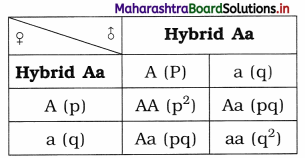
Genotypes = AA + 2 Aa + aa
Gene frequencies = p² + 2pq + q²
Question 2.
Make a chart showing the types of isolating mechanisms.
Answer:
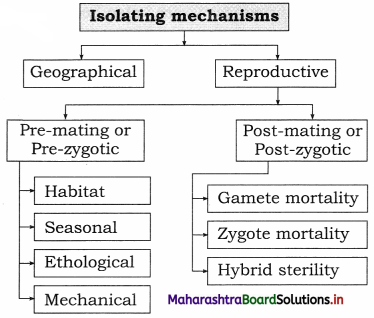
Diagram based questions
Question 1.
Give diagrammatic representation to show RNA world.
Answer:

Question 2.
Sketch and label four types of chromosomal aberrations
Answer:

Question 3.
Sketch the graphs to show directional and stabilizing selection.
Answer:
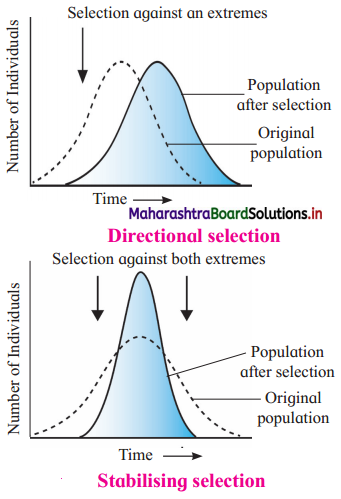
Long Answer Questions
Question 1.
Write about four old theories which suggested about how did life originate on the earth.
Answer:
1. Theory of special creation : Theory of special creation is the oldest theory which is based on religious beliefs. According to this theory, all the living organisms were created by supernatural power. However, since there are no scientific proofs to this theory, it is not accepted.
2. Cosmozoic theory/Theory of Panspermia : This theory says that life did not originate on the earth but it was exported from the other planets in the form of biological spores or microorganisms which were named as cosmozoa or panspermia. They may have descended to the earth from other planets. Recently, NASA has reported fossils of bacteria-like organisms on a piece of Martian rock recovered from Antarctica. Such facts may throw some light on the cosmozoic theory.
3. Theory of spontaneous generation or Abiogenesis : There was a belief that life originated from non-living material spontaneously. This theory was later disproved by Louis Pasteur.
4. Theory of biogenesis : This theory says that living organisms can originate only from pre-existing living beings. It is same as reproduction. But this theory of biogenesis was unable to explain origin of life on earth. It explains only the continuity of life.
Question 2.
Haldane described ‘Hot dilute soup’ in his theory. Describe how this soup led to formation of some important molecules.
Answer:
(1) The primitive sea containing molecules of organic substances without free oxygen was described as ‘hot dilute soup or primitive broth’ by Haldane. He proposed the theory of chemical evolution.
(2) According to this theory, the chemical evolution took place in the following steps : (a) Origin of earth and its primitive atmosphere, (b) Formation of ammonia, water and methane. These molecules dissolved in rainwater and formed the seas, (c) Then synthesis of simple organic compounds took place, followed by formation of complex organic compounds such as nucleic acids.
(3) The early molecules underwent chemical reactions such as condensation, polymerization, oxidation and reduction.
(4) The biologically important molecules such as monosaccharides, amino acids, purine, pyrimidine, fatty acids and glycerol were formed due to these reactions, utilizing the sources of energy on the primitive earth.
(5) Since oxygen was lacking, there was no degradation. Enzymes were also absent and hence there was formation of complex molecules in the hot dilute soup.
(6) This further led to the formation of pre-cells or protobiont. These aggregates were called coacervates by Oparin or microspheres by Sidney Fox. This further gave rise to first cells on the earth.
Question 3.
Explain the process of formation of eobionts.
Answer:
- Protobionts or coacervates were colloidal aggregations of hydrophobic proteins and lipids (lipoid bubbles).
- They grew in size by taking up material from surrounding aqueous medium.
- During their growth they became thermodynamically unstable and split into smaller units. These were called microspheres.
- They were proteinoids formed from colloidal hydrophilic complexes surrounded by water molecules.
- These bodies were like primitive cells having outer double-membrane. Across this membrane diffusion and osmosis may have occurred. They were more stable than coacervates.
- Coacervates and microspheres were non-living colloidal aggregations of lipids and proteinoids respectively.
- But they showed growth and division like living cells.
- These colloidal aggregations turned into first primitive living system called eobionts or protocell.
Question 4.
Describe RNA World hypothesis.
Answer:
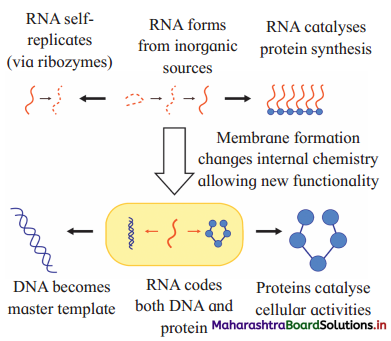
(1) RNA world hypothesis is based on discovery of catalytic RNA or ribozymes. It was proposed by Carl Woese, Francis Crick and Leslie Orgel in 1960 whereas Ribozymes were discovered by Sidney Altman and Thomas Cech in 1980.
(2) According to this hypothesis, early life must have been based most probably on RNA.
(3) Factors supporting this hypothesis are:
- RNA is found abundantly in all living cells.
- It is structurally related to DNA.
- Chains of RNA can evolve or undergo mutations, replicate and catalyse reactions.
- Biomolecules like Acetyl-Co-A have a nucleotide in their molecular structure.
- Ribosome acts as a protein assembly unit in the cell and is seen in many types of cells.
- In ribosomes, translation process is catalysed by RNA.
(4) The primitive molecules underwent repeated replication and mutation forming varieties of RNA molecules with varying sizes and catalytic properties.
(5) They later developed their own protein coats and machinery to survive the assembly of primitive cell.
(6) From them DNA was developed which was double stranded stable structure.
(7) It further kept on evolving giving rise to rich biodiversity on earth.

Question 5.
Explain in brief Darwinism and its five main postulates.
Answer:
Darwinism means theories of natural selection and speciation as put forth by Charles Darwin. The five main postulates of his theories are as follows: Overproduction or prodigality, Struggle for existence, Organic variations, Natural selection, Origin of new species (speciation).
1. Overproduction (Prodigality of nature) : There is a natural tendency to produce more number of progeny in geometric ratio for continuing the species. E.g. Salmon fish produces about 28 lakh eggs in a single season. Single pair of elephants would produce 19,000,000 elephants. But the size of given species in a given area remains relatively constant because of fluctuations that occur seasonally.
2. Struggle for existence Due to over¬production there is struggle for existence between the members of population for limited supply of food or to overcome adverse environmental conditions or for a space or to escape from enemies, etc.
3. Organic variations : There are differences in morphology, physiology, nutrition, habit, behavioural patterns, etc., among the members of same species or members of different species. These variations act as raw material for evolution.
4. Natural selection : Some organisms possess better variations to get adapted and survive under existing environmental conditions, while some do not have. Better adapted organisms are selected by the nature while those with unfavourable variations perish. The principle by which useful variations are preserved by nature, is called ‘Natural Selection’. It is also called ‘survival of fittest’ by H. Spencer.
5. Origin of new species (speciation) : Favourable variations are transmitted from generation to generation, resulting into better adapted generations. Gradually these adaptations with few new modifications become fixed in the life cycle, forming a new species.
Question 6.
Explain modern Synthetic Theory of Evolution in brief.
Answer:
(1) Modern synthetic theory of evolution is the result of modification of Darwinism and theory of mutations by taking into consideration studies of genetics, ecology, anatomy, geography and palaeontology.
(2) Five key factors of modern synthetic theory are gene mutations, mutations in the chromosome structure and number, genetic recombinations, natural selection and reproductive isolation. All these finally contribute in the evolution of new species or process of speciation.
(3) Population or Mendelian population is the small group of ‘interbreeding populations’. For every Mendelian population there is a gene pool which is constituted by total number of genotypes in it. The genotype of an organism in a population is constant, but the gene pool constantly undergoes change due to different factors such as mutations, recombination, gene flow, genetic drift, etc.
(4) Every gene has two alleles. The proportion of a particular allele in the gene pool, to the total number of alleles at a given locus, is called gene frequency. Thus any change in the gene frequency in the gene pool affects population.
(5) The five main factors are broadly divided into three main concepts as follows:
(i) Genetic variations caused due to various aspects of mutation, recombination and migration. Such variations cause change in the gene frequency. Gene mutations or point mutation change the phenotype of the organism, leading to variation. Recombination is caused due to crossing over in which new genetic combinations are produced. Sexual reproduction due to fertilization of gametes also cause recombinations. All these lead to variations, Gene flow is movement of genes into or out of the population, either due to migrations or dispersal of gametes.
Gene flow therefore change the gene frequencies of the population. Genetic drift is a random change which occurs by pure chance. It occurs in small populations but change the gene frequency. Chromosomal aberrations are structural or morphological changes in the chromosomes causing rearrangement of the sequence of genes.
(ii) Natural selection is said to be the main driving force in evolution. It brings about evolutionary changes by selecting favourable gene combinations by differential reproduction of genes. This brings about changes in gene frequency from one generation to next generation.
(iii) Isolation means the separation of the population of a particular species into smaller units which prevents interbreeding between them. This over a long time period leads to speciation or formation of new species.
Question 7.
What are different types of chromosomal aberrations?
Answer:
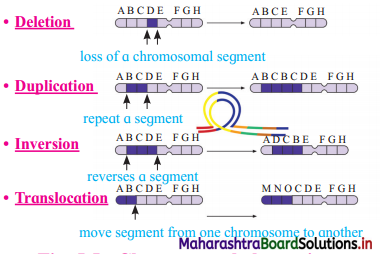
Chromosomal aberrations:
(1) The structural, morphological change, which take place in chromosome due to rearrangement, is called chromosomal aberrations.
(2) The aberrations change the sequence of the genes. This causes variations. Chromosomal aberrations are mainly of following four types:
- Deletion : Loss of genes from chromosome.
- Duplication : Genes are repeated or doubled in number on chromosome.
- Inversion : A particular segment of chromosome is broken and gets reattached to the same chromosome in an inverted position due to 180° twist. There is no loss or gain of gene complement of the chromosome.
- Translocation : Transfer or transposition of a part of chromosome or a set of genes to a non-homologous chromosome is called translocation. It is effected naturally by the transposons present in the cell.
Question 8.
What are the different pre-zygotic isolating mechanisms?
Answer:
(1) Pre-zygotic or pre-mating isolating mechanisms do not allow individuals to mate with each other at all.
(2) By various mechanisms the two groups remain isolated. These mechanisms are of following types:
(i) Habitat isolation : Habitat isolation is the phenomenon in which members of a population living in the same region occupy different habitats. Hence the potential mates do not interbreed among themselves.
(ii) Seasonal isolation : In seasonal isolation, members of a population share the same region but attaining sexual maturity at the different times of the year. They thus remain isolated reproductively preventing interbreeding among themselves.
(iii) Ethological isolation : Ethological isolation is seen when members of two populations have different mating behaviours. This prevents interbreeding.
(iv) Mechanical isolation : Mechanical isolation is seen when the members of two populations have differences in the structure of reproductive organs. Due to such differences interbreeding is not possible.
Question 9.
What are the different post-zygotic isolating mechanisms?
Answer:
- In post-zygotic or post-mating isolating mechanisms, the two individuals can mate but the result of mating is not favourable.
- Thus the populations remain isolated without the actual genetic exchange.
Post-mating isolating mechanisms are divided into the following categories:
- Gamete mortality : In gamete mortality, there is death of gametes. Sperm transfer may take place but the egg is not fertilized due to gamete mortality.
- Zygote mortality : In zygote mortality, the zygote is formed but it fails to thrive. Though the egg is fertilized the zygote does not survive.
- Hybrid sterility : In this isolation, there is the formation of hybrid as the gametes or zygotes do not die but the hybrid formed is sterile. Sterile hybrid cannot contribute genetically to further generations.

Question 10.
What is Hardy-Weinberg equilibrium? Explain it in brief.
Answer:
- Hardy and Weinberg were two scientists who proposed a concept of genetic equilibrium popularly known as Hardy- Weinberg principle or equilibrium.
- This principle states that gene, allele or genotype frequencies remain the same from generation to generation unless disturbed by factors like mutation, non-random mating, genetic drift, etc.
- For explaining the concept of equilibrium they assumed that there are two alleles located at a single locus (A and a).
- Their respective frequencies are p and q.
- The frequency of genotype AA is p, for 2Aa is 2pq and for aa is q.
- The equilibrium equation is p² + 2pq + q² = 1
- It says that if sum total of gene frequencies is 1, then sum total of genotype frequencies is also equal to 1. When the equilibrium is disturbed then only evolution occurs.
Question 11.
Human being is said to be most evolved, intelligent living being. Yet we are not self-sufficient. Think of various aspects for which we depend on other living beings for our survival.
Answer:
Human brain is evolved and super- specialised but yet in many aspects human beings are much dependent on other natural factors. Human body is not with any protective exoskeleton, or organs of offence and defence.
Unless well dressed, he cannot cope up with severe cold temperatures as he lacks natural protective fur. He cannot run fast as the other animals can. Neither he can digest uncooked food. He has overcome all his shortcomings by using his brain power.
He has managed to take fur and feathers from other animals by killing them. He also uses other natural fibres from plants to cover his body. He has also finished fish from the oceans by over-exploitation and polluting the natural habitats of these creatures.
He takes meat from other animals by killing them and for the purpose he domesticates them to satisfy his hunger. Before technical age, animals were used as beasts of burden and as means of transport. Thus human history has shown excessive use of horses, camels, elephants, etc.
Man snatches milk from other animals like cows and buffaloes which is for their young ones. But the entire diary industry and human needs for dairy products have been taken care of by these herbivores.
Apart from all such uses, man also uses other animals for experimentations and pharmaceutical industries. In this way, man has mastered other animal kingdom due to his intelligence.
![]()
![]()
![]()
![]()
![]()
![]()
![]()
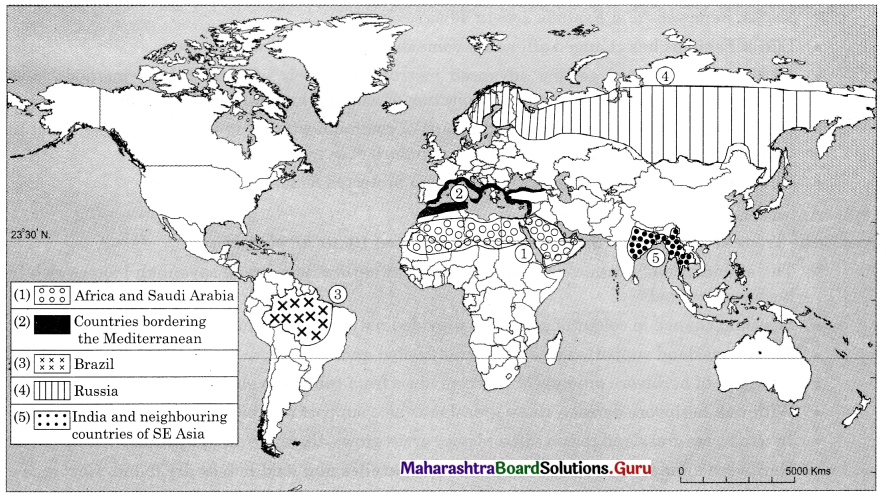
![]()
